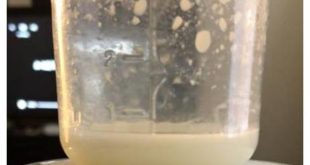
Women have two breasts instead of one so that they can nurse twins, so it stands to reason that the average mother with two breasts will be able to produce enough milk for one baby (at least).
Since breast milk intake can’t be measured without using scientific equipment or expressing it and putting it in bottles, it’s important to know how to tell if your baby is getting enough.
Here are some guidelines to help you assess your baby’s milk intake:
- Your milk should “come in” 2-5 days after your baby is born. Your baby is born with extra fluid in his tissues, which is excreted during the first 48 hours after birth (this weight loss usually averages 7-8 ounces). Because his immature kidneys are not equipped to handle large amounts of fluid, he doesn’t need any supplemental feedings during this time. The small amount of colostrum (the sticky yellow fluid that comes out of the breast before the milk “comes in’) is perfect for his newborn system to digest, and provides important antibodies. During the first 24 hours after birth, you usually produce about 37 ml of colostrum (30 ml is an ounce). The baby will get 7-14 ml at each feeding, about 1/3 to 1/2 ounce each time you nurse.
- Usually on the second or third day, your breasts will start to feel ‘different’: warmer, fuller, and heavier. (See Engorgement) You will begin to produce transitional milk at this time – a combination of colostrum and mature milk, which will look yellowish. If you don’t feel these breast changes and your baby seems hungry after feedings, consult a health care professional and have your baby weighed.
- Your baby should latch on and suck rhythmically for 10-15 minutes on each breast. He may pause periodically, but should nurse vigorously for most of the feeding. He should seem satisfied after nursing, and will often fall asleep at the second breast. If he falls asleep and will not take the second breast, try to divide the sucking time between the two sides. If he is sleepy, he will get more milk by nursing for 5 minutes on both breasts rather than 10 minutes on one. You should hear him swallowing regularly while he is nursing.
- Your newborn should nurse at least 8 times in 24 hours. Many newborns will nurse 10-12 times or more. This includes longer feedings as well as shorter snack nursings. Nursing every 1 ½ – 3 hours during the day, with one 4 hour stretch at night (if you’re lucky!) works well for many nursing couples. Don’t expect your baby to be on a 4 hour schedule – the average newborn will not gain enough weight that way. You may need to wake your newborn up for feedings – newborns will often not demand to be fed often enough, especially during the first week or two.
- Once your milk is in, your breasts should feel fuller before feedings and softer after you nurse. You may see milk dripping or squirting from one breast while your baby is nursing on the other side. This is a sign that your milk is “letting down’. Your body doesn’t know that you’re not nursing twins, so your milk will let down on both breasts at once. You may or may not feel a distinct sensation associated with the milk ejection, or let down reflex. Some mothers feel a very strong physical sensation, sort of a tingling, tightening, or ‘pins and needles’ response as the milk begins to flow. Some mothers never notice a distinct sensation, and some don’t feel it until they have been breastfeeding for several weeks.
- Keep track of your baby’s wet diapers and bowel movements. Other than weight gain, these are probably the best indicators of how much milk your baby is taking in.
- For the first couple of days after birth, your baby will pass dark, tarry meconium stools. This is the stool the baby has been storing since before birth. Within a day or two of your milk coming in, his stools will change in both color and consistency. These early transitional stools may be brownish or greenish, and will be loose and unformed (kind of a pea soup consistency). By the time your baby is 4 or 5 days old, he should be having “milk stools”: Yellowish and seedy, sort of like a mixture of mustard and cottage cheese. He should have at least 2-5 substantial bowel movements in each 24 hour period, and may pass a stool every time he nurses during the first few weeks of life. If he is stooling less frequently, it may mean that he is not getting enough milk.
- During your baby’s first couple of days of life, he will probably wet only once or twice a day, since he is receiving only small amounts of colostrum. After the milk comes in, he should wet 6-8 times in 24 hours. It is often hard to tell whether a super absorbent disposable diaper is wet or not, since the gel inside acts like a wick to draw the moisture away from the surface. You can put a piece of toilet tissue inside the diaper the help you be sure. The urine should be pale, colorless, and mild smelling. Dark, concentrated urine may mean that the baby is not getting enough milk.
- Most mothers experience some nipple tenderness during the early days of nursing. The discomfort is usually worst when the baby first latches on, and eases off during the feeding. If the pain is severe, lasts all the way through the feeding, if your nipple tissue cracks or bleeds, or the pains persists beyond one week, it may mean that your baby is not latching on correctly. This can not only cause you extreme discomfort and make feedings unpleasant, but can also cause your baby to not obtain enough milk. Check your baby’s weight, and consult a lactation consultant who can evaluate your nursing technique. Latch on problems can usually be easily corrected. (See Sore Nipples)
The only way to be absolutely sure that your baby is getting enough milk is to check his weight regularly. Remember that it is normal for him to lose 5-7 % of his weight in the first couple of days. Doctors seldom become concerned until weight loss approaches or exceeds 10%. For the average baby, this is close to a half a pound weight loss (often more for larger babies).
You need to ask what your baby’s discharge weight is when leaving the hospital, because that is the figure you will be calculating his weight gain from, not from his birth weight. For example: your baby weighs 7 lbs 8 oz at birth. 24-48 hours later when you leave the hospital, he weighs 7 lbs 1 oz. Once your milk comes in, your baby should gain about an ounce each day for the first several months of life. Most babies will regain their birth weight within 2 weeks. Many doctors are pleased if the baby has regained his birth weight by then, and will do a weight check at that time. Some doctors are satisfied if the baby regains his birth weight by 3 weeks.
I like to see babies regain their birth weight by 10 days, and most babies will do that if breastfeeding is progressing smoothly. Some doctors check the babies weight around the third day of life, and then make a follow-up appointment for 2 weeks to see if he has regained his birth weight. I strongly encourage mothers to check the baby’s weight at about one week – at that point, her milk should be in, the baby should have good urine and stool output, he should be gaining weight, and any breastfeeding difficulties can be addressed. Breastfeeding problems are much easier to remedy if recognized and treated early. Some doctor’s offices will offer free weight checks, since the doctor does not need to do an examination. Call your doctor’s office to find out if this is an option for you. If your milk has come in and your baby has started to gain weight, you know that breastfeeding is going well. Once babies start gaining weight, they don’t start losing it unless there is some kind of medical condition causing it.
When the nurse puts put the baby on the scale you’ll know exactly how much weight she has lost or gained. Remember that she lost weight in the hospital, so that is your baseline, and her weight gain or loss will be calculated from that starting point, and not from her birth weight. The information you get will be invaluable – either you will know that breastfeeding is going well, and you can relax, or you will know that there is a problem that needs to be addressed and you can take care of it before a little problem develops into a big one.
If you notice any of the following symptoms (especially if they occur concurrently with other “red flags’ such as low urine and stool output), contact your doctor ASAP.
- lethargy
- listlessness
- weak cry
- dry mouth or eyes
- the fontanel (soft spot) on the baby’s head is sunken in or depressed
- the skin loses its resilience (when you pinch it, it stays pinched looking instead of retracting)
- fever
- urine that is dark, or contains tiny reddish crystals. These crystals (sometimes called ‘brick dust’) are caused by a buildup of uric acid, causing the milk to become concentrated. This isn’t unusual during the first 24-48 hours after birth, because the baby is taking in only small amounts of colostrum. Once the milk ‘comes in’, the baby should be taking in enough fluid to make the urine clear. If the baby is 4-5 days old and still has concentrated urine and ‘brick dust’ in his diaper, it may be a sign that he’s not getting enough milk.
One last note on this topic:
Every mother’s nightmare is that she won’t have enough milk and her baby will become dehydrated. Horror stories abound, and unfortunately, this has (rarely) occurred. There is absolutely no reason for this to happen if you follow the above guidelines. True dehydration is an extremely uncommon medical occurrence, and there are clear warning signs which indicate that your baby needs more fluids immediately, if you know what to be on the lookout for.
Anne Smith, IBCLC
Breastfeeding Basics
(Edited September 2016)
*Please ‘Pay it Forward’!*
If you found this article helpful, please consider making a small donation to my favorite cause – Project Pets: Spay, Neuter, Love – an all volunteer, non-profit organization that provides free spay and neuter services for homeless rescue dogs and cats…because every baby deserves a home, whether they have two legs or four!
For more information on Project Pets, visit them on Facebook.
Thanks for your support. Every dollar helps create a happy ending for a furbaby!

 Breastfeeding Basics
Breastfeeding Basics




